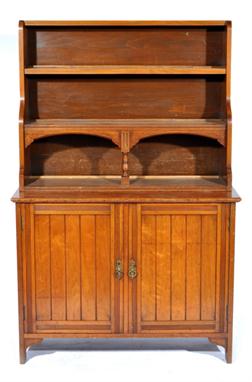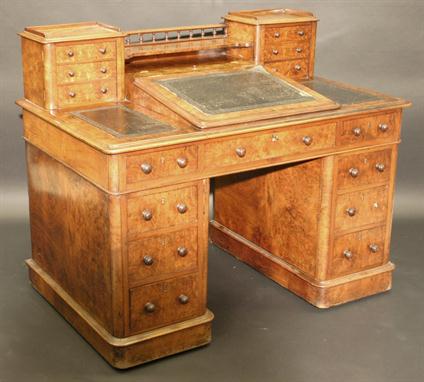We found 104477 price guide item(s) matching your search
There are 104477 lots that match your search criteria. Subscribe now to get instant access to the full price guide service.
Click here to subscribe- List
- Grid
-
104477 item(s)/page
John Hogan (1800-1858) Bust of Francis Sylvester Mahony ("Fr. Prout") Marble, 50cm high (19.75") Made in Rome 1846 and signed Hogan Provenance, by descent in the family of the subject Literature "John Hogan, Irish Neoclassical Sculptor in Rome" (Irish Academic Press, 1982) where it is listed as No. 58 in the Catalogue Raisonné. Mahony wrote a description of Hogan's studio in Rome in the spring of 1847 which mentions his own portrait bust. "The locale which forms this sculptor's workshop (once tenanted by Canova) presents just now what may be termed a sort of Hibernian Valhalla…the bust of Father Mathew looks forth redolent of Christian philanthropy: on the same shelf is seen the mirthful brow of Father Prout…the late venerable Mr Beamish of Cork as well as his meritorious partner William Crawford, both models to any mercantile community, have their representations here, with several Murphies from that city." The bust was made before May 1847 so it is unlikely to have been this bust for which Mahony sat for Hogan in November 1847 as Turpin writes. The date is therefore likely to be 1846 rather than 1848. Turpin notes the low relief carvings on either side of the base. On one side an open chest with rolls of parchment and an antique lamp - an illusion to the 'discovery' of Fr Prout's literary remains in a chest - and on the other a book, a wine bottle, a chalice and a classical flask - apt symbols of Mahony's life. Francis Sylvester Mahony (Fr Proust) (1804-1866) "A very singular person, of whom the world tells a thousand and one tales, you know, but of whom I shall speak as I find him, because the utmost kindness and warmheartedness have characterised his whole bearing towards us….a most accomplished scholar and vibrating all over with learned associations and vivid combinations of fancy and experience - having seen all the ends of the earth and the men thereof, and possessing the art of talk and quotation to an amusing degree." Elizabeth Barrett Browning, 10th October 1848 Francis Mahony was born in Cork on 31st December 1804, the son of Martin Mahony a woollen merchant. He went to Clongowes in 1815, to the Jesuit college of St. Acheul at Amiens in 1819 and then to Paris as a Jesuit novice. From 1823-1825 he studied in Rome. He was "brilliant but intractable and ill-disciplined". Eventually he was told that he was not suitable for ordination as a Jesuit. Returning to Ireland still intent on ordination he was made Prefect of Studies at Clongowes and then Master of Rhetoric. Then disaster struck. He took a party of boys on an outing to have dinner in Maynooth. The boys got drunk and returned to Clongowes on turf-cutters' carts after midnight. Mahony resigned his post. He went abroad, continued his studies and was eventually ordained, but not as a Jesuit, in 1832. He served bravely in Cork during the Cholera epidemic of 1832 but again fell out with his superiors. After two years he went to London, gave up life as a priest and began the career in journalism for which he is remembered. His relations with the Church have continued to be uncertain. A friend wrote after his death that "he might have had a cardinal's hat but for that which is imputed to him as his one great fault - conviviality" Mahony loved the sociable, literary world of London. He wrote for Fraser's Magazine under the pseudonym of "Father Prout", allegedly the parish priest of Watergrasshill, near Cork. The editor William Maginn, Thomas Crofton Croker, the antiquarian and collector of Irish fairy stories and Daniel Maclise, the artist, were other Cork-born contributors. Mahony's writing shows him to have been a classical scholar, linguist and wit. He described himself as "an Irish potato seasoned with Attic salt." As a joke he alleged that Thomas Moore, then at the height of his success, was just a plagiarist, merely translating from French, Greek or Latin poems or other "originals" which Francis supplied. The Bells of Shandon - for long included in the Oxford Book of English Verse - was written as the supposed original of Moore's Evening Bells - a St Petersburg Air. Many of these articles were collected as The Reliques of Father Prout. From 1837 he wrote for Charles Dickens's Bentley's Miscellany from Italy. His contributions were collected and published in 1847 as Facts and Figures from Italy by Don Jeremy Savonarola - another pseudonym - with a brief foreword by Dickens. Mahony settled finally in Paris where for eight years he was the correspondent of The Globe and where he died in 1866. He is buried at Shandon in Cork. One of his obituarists wrote "Indeed Francis Mahony… was no common man, either in genius or expression. Many elements met in him, as in a mayonnaise, to make a piquant mixture. He was a Jesuit and a humourist; a priest and a Bohemian; a scholar and a journalist; a wag and a song-writer; a Cork man familiar to everyone in Rome, a Roman Catholic ecclesiastic well known in the convivial clubs of London."
EARLY 20TH CENTURY ART NOUVEAU DESIGN MAHOGANY DISPLAY CABINET, having moulded cornice over two convex glazed doors, open mirror backed display shelf below, two blind panelled cupboards on square legs with apron. Overall inlaid with Art Nouveau foliate designs. C1900. 35.5" Wide x 15" Deep x 70" High.
OO gauge, Wrenn W3004/5 `Brighton Belle` 2-car set, both cars appear G/VG with some slight tissue paper residue over body, yellowing to windows, (F worn box with tape mark, price sticker mark, price sticker and one slight tear, G internal boxes are slightly worn, marked `powered` and `non-powered` with stickers to one end). Together with three Wrenn `Brighton Belle` passenger coaches: consists of W6004.A, 2x W6005.A, VG in G boxes with slight shelf wear, one creased to corner. (4).
OO gauge, nine Hornby `Top Link` steam locomotives: consists of R646 Beatties Limited Edition BR 4-6-2 tender `501 Squadron 34085 Golden Arrow`; R2021 BR 4-4-0 tender `Cattistock 62758`; 3x R2055 BR 2-8-0 `48705`; R2016 BR 2-10-0 tender `92001`; 3x R2057 BR 2-10-0 tender `92212`. All appear G/VG, boxed (some boxes have some shelf wear). (9).
Four Boxed Corgi Cars:- Chevrolet New York Taxi Cab No.221, in orange with red interior; Chevrolet State Patrol No.223, in black with yellow interior; Ford Zephyr Motorway Patrol No.419, in white with red interior; Chrysler Ghia No.241, in metallic blue with red interior, dog on shelf (playworn condition)
An early Victorian mahogany chiffonier, the raised back with scrolling acanthus carved top rail above a plain shelf on lotus leaf carved S scroll supports, the plain top above a cushion drawer and two plain panelled doors flanked by half cut reeded tapering side pilasters to foliate carved squat sabre front supports, 90.8 cm wide (ILLUSTRATED)
A Victorian walnut veneered desk in the manner of C & R Light, the top with central galleried shelf flanked by two chests, each with three quarter galleried top and moulded edge over three drawers with Wellington style locking mechanism, over a central writing slope with lidded stationery compartment opening to reveal a basic fitted interior with five pigeon holes flanked by two further tooled leather writing surfaces within a moulded edge over three frieze drawers with turned knob handles raised on two pedestals, each of three drawers with turned knob handles to plain plinth bases, left pedestal drawer stamped "Kerry, 545 New Oxford St", 123 cm wide (ILLUSTRATED)
A circa 1900 French rosewood and brass embellished armoire in the Louis Philippe taste, the moulded cornice with foliate decorated lidded urn surmount over a single mirror door enclosing adjustable shelf with attached drawer flanked by turned and fluted tapering side pillars over a single drawer raised on turned tapering supports to brass caps, 112.5 cm wide x 244 cm high (ILLUSTRATED)
An early 20th Century Chinese blackwood Bonheur-du-Jour of angled form, the superstructure with boldly fretted and carved fruiting vine pattern rear panel, fitted two small cupboards, corner shelf and one small drawer, panelled writing surface, fitted one frieze drawer, the drawer front and frieze carved in bold relief with fruiting vines and gadroon ornament, on carved cabriole legs with paw pattern feet, 42ins wide x 24ins deep x 46.5ins high (centre flush panel shrunk forming gap to front)
A Victorian mahogany wall mounted medicine cabinet with open shelf and cupboard under, 24ins wide x 6ins deep x 25ins high, a late Victorian walnut three tier wall shelf with fretted sides, 25ins wide x 6ins deep x 26ins high, and an Edwardian mahogany wall mounted letter rack, 16ins x 13ins (slightly damaged)
-
104477 item(s)/page














































